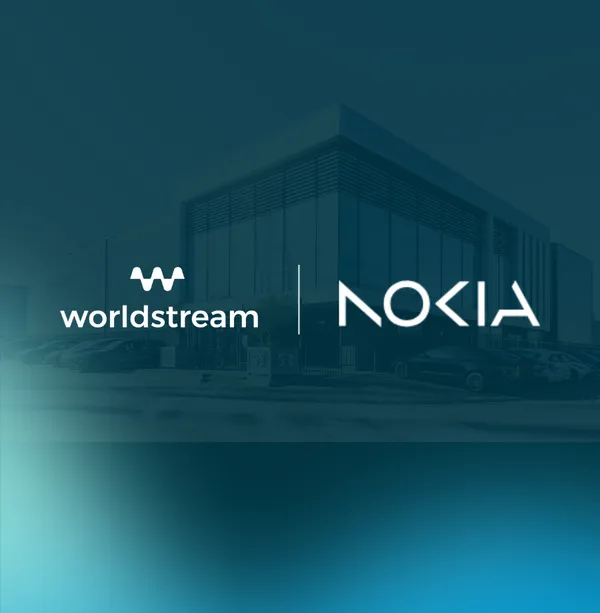A Solid Network Backbone – The Core for Any IT Infrastructure

Knowledge blog

The core of your IT infrastructure and business operations is the network. It doesn’t matter if you’ve deployed a private cloud, co-located IT resources, hybrid cloud, hosted dedicated servers, multi cloud, or any other type of infrastructure, the network backbone largely determines the end user experience. We will elaborate in this article on what the exact business value of a solid network backbone is for a variety of industries.
The network is the centerpiece of any IT organization
A network infrastructure makes it possible to connect and communicate with clients, partners, or employees, both of which are essential for any business to succeed. It’s a prerequisite for a good functioning of locally deployed IT infrastructures while it may also connect an IT infrastructure to ‘the edge’, at regional and/or global scales, meeting contemporary demands such as set by Internet of Things (IoT) applications, video collaboration, and the increasing trend of working remotely. Hardware and software systems wouldn’t be very useful without a solid, well-connected network infrastructure interlinking them and connecting them to the outside world.
Distributed Organizations
When it comes to distributed (enterprise) organizations, which may for example include a headquarters, branch offices, distribution centers and/or manufacturing plants, and a mobile workforce, it’s true that they can only be as successful as the network supporting their operations. Both staff and clients will likely experience the benefits of utilizing a strong network architecture for their IT infrastructures. It may for example begin with establishing communication between a centralized hub and various geographical dispersed facilities. Wherever there is the presence of specialist equipment, performance monitoring and video surveillance might be included into the network architecture as well. In addition, the network might need to be capable of (real-time) updating an organization’s inventories while meeting unique supply chain management requirements.
This is the point when the actual power of a solid network backbone such as offered by Worldstream may come into focus. The productivity of employees, the alignment of departments, and the interaction between IT systems will all increase as a result. A robust network architecture will also allow for improved inventory management, by using the power of technologies such as GPS and RFID chips. The effective outcome may entail a reduction in the amount of money lost due to unnecessary shipping expenses as well as fewer resources lost due to products gathering dust on store shelves. In short, companies have a better chance of flourishing when they are connected to a robust network backbone.
SaaS, e-Commerce, AdTech, FinTech, Gaming
The use of a robust network backbone such as offered by Worldstream is also an incredibly crucial precondition for the provision of Software-as-a-Service (SaaS) applications or, for instance, the streaming of events or video, whether on a local, national, or international scale. The network backbone that is utilized for SaaS or streaming applications may determine whether a service will be successful in the marketplace. The same may be said for a variety of different markets, such as e-commerce, AdTech, FinTech, and gaming. In each of these sectors, the quality of the network that a service provider utilizes is of critical significance. A service provider will not be able to differentiate themselves from the competition in these types of sectors, particularly when they serve customers on an international scale, unless they have a solid network backbone in place.
So, for practically every IT infrastructure and business application, the caliber of the network backbone that is established is genuinely crucial for attaining excellence in IT infrastructure, but what considerations support a solid and reliable network backbone?
The R&D and networking team at Worldstream has developed a very extensive global network backbone with high bandwidth for our customers, allowing them to efficiently deploy IT resources and effectively connect their IT systems with the outside world. So yes, we sure know what we are talking about when discussing technical considerations to establish a solid network. Worldstream’s technical considerations have resulted in a low latency global network backbone, adding to the high client satisfaction rate being achieved with a NPS (net promoter score).
High Network Bandwidth – Its Security Value
The amount of network bandwidth available, in addition to high network speed and low network latency, is one of the most essential components of a fast and reliable connection delivered by a network backbone. Network bandwidth determines how much data can be sent across a connection at once. Let’s start with discussing the value of high network bandwidth when it comes to securing an IT infrastructure and ensuring business continuity.
Findings from Cloudflare’s DDoS Threat Report for the fourth quarter of 2022, published in this recent blog post, demonstrate the threat that large-scale Distributed Denial of Service DDoS attacks pose to IT infrastructures. The volume of HTTP DDoS attack traffic surged by 79% year over year in the last quarter of 2022, according to Cloudflare. Despite the fact that the majority of these attacks were small, Cloudflare regularly witnessed terabit-strong assaults carried out by sophisticated botnets; DDoS attacks that sent hundreds of millions of packets per second, and DDoS attacks that even peaked at tens of millions of requests per second.
A high bandwidth network is better equipped to withstand such high-volume DDoS attacks than a smaller network with lower capacity. High bandwidth is therefore crucial for any business network imaginable, including those that are merely local or regional in scope.
High Network Bandwidth - Additional Values
A high volume of available bandwidth in a network backbone has many more benefits than the security aspect alone though. Let’s be complete in this article and discuss the other benefits of high network bandwidth as well.
- Optimize application performance – Organizations may guarantee that their websites and business applications react to user requests truly fast by expanding the network bandwidth which will boost user engagement and customer satisfaction. This is because the speed of data transport will increase significantly by increasing the network bandwidth. This can be relevant for any organization but especially be crucial for companies depending on real-time interactions with their clients, such as businesses within e-commerce, video distribution, or online gaming. Additionally, increased network bandwidth may boost the effectiveness of internal business operations including data transmission between departments and cloud-based business applications.
- Facilitate concurrent use of applications – With high network bandwidth available, businesses are ensured that their website or business application can manage large amounts of traffic without compromising speed or user experience by allowing for more concurrent visitors. Expanding the number of concurrent users that a website or business application can handle may lead to higher customer retention rates and increased revenue sources. Companies able to manage large user volumes may take advantage of this by launching focused marketing campaigns and promotions, which can further promote growth and profitability.
- Prevent application failures and website bounces – Customers and employees may get frustrated with a sluggish or unresponsive website or business application, which might lead to negative user experiences, declining productivity, and lost purchases. Higher network bandwidth able to handle the demand helps to protect the server from compromise and to provide website and business application users a good experience. Businesses may steer clear of a negative user experience by opting for higher network bandwidth, guaranteeing that website and business application users can quickly access the data and services they need.
- Stream video and audio faster – The supply of streaming music and video content has grown significantly in recent years. High network bandwidth will allow videos and podcasts to be transmitted to viewers more quickly, preventing buffering and resulting in a smoother and more pleasurable watching or listening experience. High network bandwidth is also a prerequisite for effective Communications as a Service (CaaS) solutions, notably video conferencing services. Video conferencing has emerged as a crucial tool for organizations to connect with both customers and employees, also because of the worldwide remote work trend. Without sufficient network bandwidth, delays, dropouts, and poor visual and audio quality may occur during video conferencing sessions. By expanding the network bandwidth capacity, a negative development like this can be avoided.
- Capitalize on business growth – Another benefit of a network backbone with ample available network bandwidth is scalability. It enables companies to adjust to shifting market circumstances, handle more traffic, anticipate sudden peaks in traffic, and satisfy client demand. For instance, an e-commerce website may swiftly scale up its operations to meet the increased demand if it has a sudden spike in traffic during the Christmas holiday season. Only a network backbone with the ability to manage the extra traffic without sacrificing performance will be able to facilitate it.
High Network Redundancy – Why It Is Important
For organizations deploying IT infrastructures, especially the ones with mission-critical operations, selecting a network backbone with the highest redundancy as offered by Worldstream is also of key importance. It is a critical strategy that organizations may use to safeguard the operations of their IT infrastructure against single points of failure, providing numerous business benefits including improved IT infrastructure security, performance, as well as reliability.
Unforeseen network outages can significantly impact IT infrastructure and business continuity. Distributed Denial of Service (DDOS) attacks and other types of assaults can disrupt business applications and their use, causing damage to an organization’s operations. By providing alternative network routes for compromised network traffic, network redundancy can minimize IT infrastructure and therefore business outages, reducing the risk of network and asset vulnerability.
To ensure that data can continue to flow even in the case of a breakdown, the design of a network backbone must be highly redundant. Simply put, more redundancy equates to greater reliability. The idea is that if one piece of equipment or part of the network malfunctions, another piece or part of the network may take over immediately, reducing the likelihood that a failure will bring the network backbone down as well as the IT infrastructures running on it.
One cannot overestimate the business value of having a high level of redundancy in the network backbone. When a major network path becomes blocked or stalled, a highly redundant network architecture may offer backup routes for the network traffic. In doing so, organizations who rely on the backbone for their operational continuity can be confident that the network will continue to function at its best and be secure and reliable.
A network backbone usually connects several internal and external as well as geographical distributed networks, providing centralized communication routes for data to travel between different parts of the backbone. To balance efficiency, costs, and reliability, backbone providers including Worlstream tend to employ IP transit as well as network peering through Internet Exchanges (IXs) for their network traffic, thereby enhancing the overall redundancy of the network backbone.
Edge Computing – Supported by the Network Backbone
We touched on it briefly at the beginning of this article, the importance of a quality network backbone for effectively executing an edge computing strategy. A solid network backbone as delivered by Worldstream typically provides excellent opportunities to shape ‘edge’ operations for an organization.
A wide range of sectors, including manufacturing, retail, as well as healthcare and agriculture, can be transformed by employing an edge computing strategy. It may move data analytics, processing, and storage closer to the network’s edge, which may be a patient’s home device, a manufacturing facility, or a retail establishment. This proximity of compute, storage and network resources at the user level may enhance data processing effectiveness and speed while allowing for rapid (real-time) decision-making. However, a solid network backbone is necessary to enable a successful edge computing approach. We’ll provide a few examples of sectors to illustrate the potential of edge computing and the value of a strong network foundation.
- Agriculture at the edge – In agriculture, sensors may gather data to grow crops, while edge computing is used to make informed decisions about crop irrigation, nutrient density, and the best times to harvest. The sensors need a strong network backbone that can manage the data volume and provide other network traffic channels in case the main line is blocked.
- Healthcare at the edge – Edge computing can also be utilized in healthcare to safeguard patient data and continuously monitor patients’ vital signs. Patients may employ wearable equipment which creates and receives data no matter where the user is. Again, in these cases a strong network backbone is required to make sure that this data is transferred swiftly and reliably.
- Content delivery networks – Identifying the best, low-latency network path for a user’s data traffic while offering a widely distributed global cache or data repository for servers, edge computing may also improve content delivery networks (CDNs) for optimized content distribution. It may provide smooth content delivery for customers, and a strong network backbone is necessary to guarantee that the resources will be delivered swiftly and reliably.
- Industry 4.0 or manufacturing at the edge – By capturing and transmitting data close to each individual plant location’s server, edge computing in manufacturing may allow for quicker and more accurate operational choices. A strong network backbone will be required to guarantee that data is sent fast and reliably while effectively enabling management decision-making based on real-time data.
- Retail business at the edge – In the retail industry, edge computing may enable distribution centers close to clients to process and properly complete online purchases. This will allow retailers to more accurately make predictions towards seasonal economic shifts and forecast sales. Again, a solid network backbone will be required to process all data and guarantee that these online purchases are completed swiftly and properly.
- Energy infrastructure at the edge – Edge computing in the energy sector may offer real-time data from IoT sensors at for example drilling sites or power plants, which expedites the identification and resolving of technical or security issues that arise in the sector. Also here, to guarantee that the data is transferred swiftly and reliably, and that businesses are enabled to base their judgments on real-time data, a solid network backbone is required.
In short, edge computing has revolutionized several sectors while allowing prompt decision-making based on real-time data. However, a solid network backbone such as offered by Worldstream is necessary to enable a successful edge computing approach.
Virtualized Edge – Using SDN and NFV Technology
The emergence of edge computing has further increased the need for a scalable, adaptable infrastructure that can effectively manage massive volumes of data. SDN (software defined network) combined with NFV (network function virtualization) can be useful for this purpose. SDN and NFV may virtualize computation, storage, networking, and security resources at the edge with the support of a solid physical network backbone, which has various advantages for executing an effective edge computing approach.
A key benefit of SDN is that it separates the control plane from the data plane, making the network programmable and manageable from a single location. Increased flexibility in managing network resources as a result enables network agility and a dynamic provisioning and orchestration of the network. SDN can optimize network traffic, boost network effectiveness, and save costs by giving users a single point of management. On top of its solid global network backbone, Worldstream has developed a virtualized network called the Worldstream Elastic Network (WEN), which is based on this SDN/NFV technology. The following are some of the key advantages that such a virtualized network may provide for the network edge:
- Flexibility – NFV may virtualize network components like load balancers, firewalls, and intrusion detection systems. These functions can be deployed more cost-effectively and flexibly by utilizing NFV technology, and they can also be scaled up or down as necessary. As a result, the network becomes highly flexible and responsive while compute, storage, networking, and security resources can be employed more effectively.
- Scalability – Improved scalability is another advantage of virtualization at the edge. By virtualizing the network on top of a solid network backbone, the network will be better enabled to meet demand and minimize overprovisioning, enabling resources to be scaled up or down as necessary. This will result in a more cost-effective utilization of resources and reduced overall costs.
- Security – Network security may also be enhanced via virtualization at the edge. NFV technology may provide a more flexible and scalable solution to network security by virtualizing security services like firewalls and intrusion detection systems closer to application and service users. As a result, the network’s overall security posture may be enhanced by being able to deploy security resources where they are most required.
- User experience – Edge virtualization may potentially improve the user experience. By moving resources closer to the edge, virtualization will reduce latency and improve the performance of applications and services. This can be very important because pretty much every user expects speedy and responsive applications and services.
Conclusion
A solid network backbone is key to successful IT infrastructure and business operations, connecting and communicating with clients, partners, and employees, and supporting distributed organizations. High network bandwidth can be essential for securing an IT infrastructure and ensuring business continuity, as it is better equipped to withstand large-scale DDoS attacks. It also has many additional benefits such as optimizing application performance and boosting internal business operations.
High network bandwidth enables businesses to manage large amounts of traffic without compromising speed or user experience, prevent application failures and website bounces, stream video and audio faster, and capitalize on business growth. Network redundancy is essential for mission-critical IT infrastructures to protect against single points of failure, providing improved security, performance, and reliability while reducing the risk of network and asset vulnerability. Edge computing can transform sectors such as agriculture, healthcare, content delivery networks, and manufacturing, but a strong network backbone is necessary to enable a successful edge computing approach.
The emergence of edge computing has increased the need for a scalable, adaptable infrastructure that can effectively manage massive volumes of data. SDN and NFV can effectively virtualize computation, storage, networking, and security resources at the edge with the support of a solid physical network backbone. By virtualizing the network on top of a solid network backbone, the network can easily meet demand and minimize overprovisioning, enabling resources to be scaled up or down as necessary. Additionally, network security can be enhanced by virtualizing security services closer to application and service users, and user experience can be improved by reducing latency and improving performance of applications and services.
About Worldstreams Network Backbone and Virtualized Network
Worldstream was founded in 2006 by childhood friends with a shared passion for gaming. Dissatisfied with the high costs and unreliability of game servers, they came up with the idea of offering better solutions. Since then, the Westland-based IT company has grown into an international player of IT infrastructure (IaaS).
Worldstream aims to uncomplicate the lives of IT leaders at tech companies. As a provider of data center, hardware, and network services, Worldstream serves various business markets, including Managed Service Providers (MSPs), System Integrators (SIs), Independent Software Vendors (ISVs), and web hosting companies. The key business objective of Worldstream is to give IT leaders peace of mind by providing high-quality infrastructure, industry-leading service, and strong partnerships that will get them excited about their IT infrastructure again.
Backed by its proprietary global backbone, Worldstream offers a solid Infrastructure-as-a-Service (IaaS) solutions portfolio to clients globally, which includes highly customizable bae metal servers, intelligent DDoS protection to mitigate large and under the radar attacks, colocation, and more. For clients requiring dynamic-to-deploy, virtualized IT infrastructure deployments ‘at the edge,’ we have our Worldstream Elastic Network offering available with data center deployments possible across Europe.
Powered by Worldstream’s Elastic Network, an SDN/NFV network featuring EVPN VXLAN technology and built on Worldstream’s global backbone, customers can benefit from a plethora of IaaS solutions including private cloud, public cloud on-ramps, block and object storage, firewalls, and more. You can find these IaaS services here.
You might also like:
- The Benefits of a Distributed Multi Location Data Center Setup.
- 7 Benefits of Using Public Cloud Infrastructure.
- Which 6 Advantages Dedicated Servers can bring your IT Infrastructure.
Have a question for the editor of this article? You can reach us here.

Latest blogs
CPU Steal Time on a VPS: How to Spot Contention and Decide on Dedicated
Knowledge blog

The Ultimate Gaming Latency Guide: How to Eliminate Lag and Maximize FPS
Knowledge blog

Growing smarter with less maintenance

Knowledge blog

Worldstream and Nokia Join Forces for Next-Gen DDoS Protection

News

Worldstream unveils new positioning and offers customers more control over their digital infrastructure

News

5th Gen AMD EPYC 9355P – Now Live at Worldstream

News
